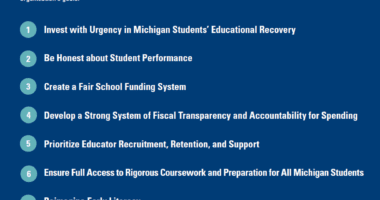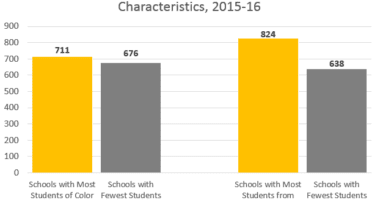Every student counts and a needed math intervention. Plus news, updates and more.
Making Sure that Every Student Counts
Earlier this month, schools across Michigan observed fall “count day.” This is one of the days used by the state during the school year to determine official student headcounts, which is used to make decisions about student funding. So while it is important for the student to be in class, ready to learn every day, on count days, the stakes are especially high for schools and communities.
The costs of frequent absences, often referred to as chronic absenteeism, are well documented, including lower student academic achievement. Ahead of count day and throughout the year, some schools and districts are addressing this challenge head-on. Grand Rapids Public Schools, for example, reports reducing chronic absenteeism by 60 percent since 2014, with their Challenge 5 campaign. And Detroit Public Schools Community District has set the goal of cutting chronic absenteeism by at least four percent each year, including by engaging with a family as absences begin to accrue – before the student is considered “chronically absent.”
Each year, count day also elevates concern around the students who aren’t counted. As we described last year in Lifting the Veil: Michigan’s Uncounted, nearly 100,000 mobile students – students who transfer between schools during the school year – are not factored into school accountability systems. This minimizes how some schools are held accountable for serving the educational needs of black, brown, poor and and migrant students.
Supporting Educators for a Math Intervention
The excerpt below is from a recent blog by Mike Arbit, policy fellow at The Education Trust-Midwest on the need to address math performance in Michigan by supporting teachers. Read the full blog here.
On national assessments, Michigan’s fourth-grade math performance slipped from 27th in the nation in 2003 down to 38th in 2017, while eighth-grade math results languished in the mid-thirties. Low-income eighth graders slid down into the bottom five in the country.
To prepare Michigan students for an ever-evolving job market – and to become active citizens of the 21st century world – the state must improve its math performance.
Such a transformation of math instruction won’t happen on its own. To make the shift, math teachers need meaningful support – high-quality instructional materials, modeling and examples of effective problem-solving lessons, and coaching and guidance from teachers who have successfully implemented 21st century instruction. In my work as a Michigan math teacher, I acutely felt the need for a comprehensive system of job-embedded professional development. Collaboration with master teachers would have significantly enhanced my practice – and my students would have reaped the rewards.
Michigan’s math proficiency requires dramatic improvement. To make this happen, the state must commit to developing students into 21st century problem-solvers – and give math teachers the training and ongoing support necessary to achieve that goal.
Capital Update
HOUSE WAYS AND MEANS meets today, October 15 at 10:30 a.m. in the House Appropriations Room in the State Capitol. The agenda includes House Bills 4546 (Kahle, R) and HB 4547 (Frederick, R), which would modify dual enrollment eligibility requirements.
Noteworthy News
- Editorial: Funnel funds toward teacher training – The Detroit News
- Arne Duncan and John King on how to improve education in America – Nandeeni Patel, Brown Center ChalkboardHow Gov. Whitmer hopes to get more Michigan students to complete college – Lori Higgins, Chalkbeat Detroit
- Who’s leading classes? Uncertified teachers for thousands of Michigan kids – Mike Wilkinson, Bridge Magazine






